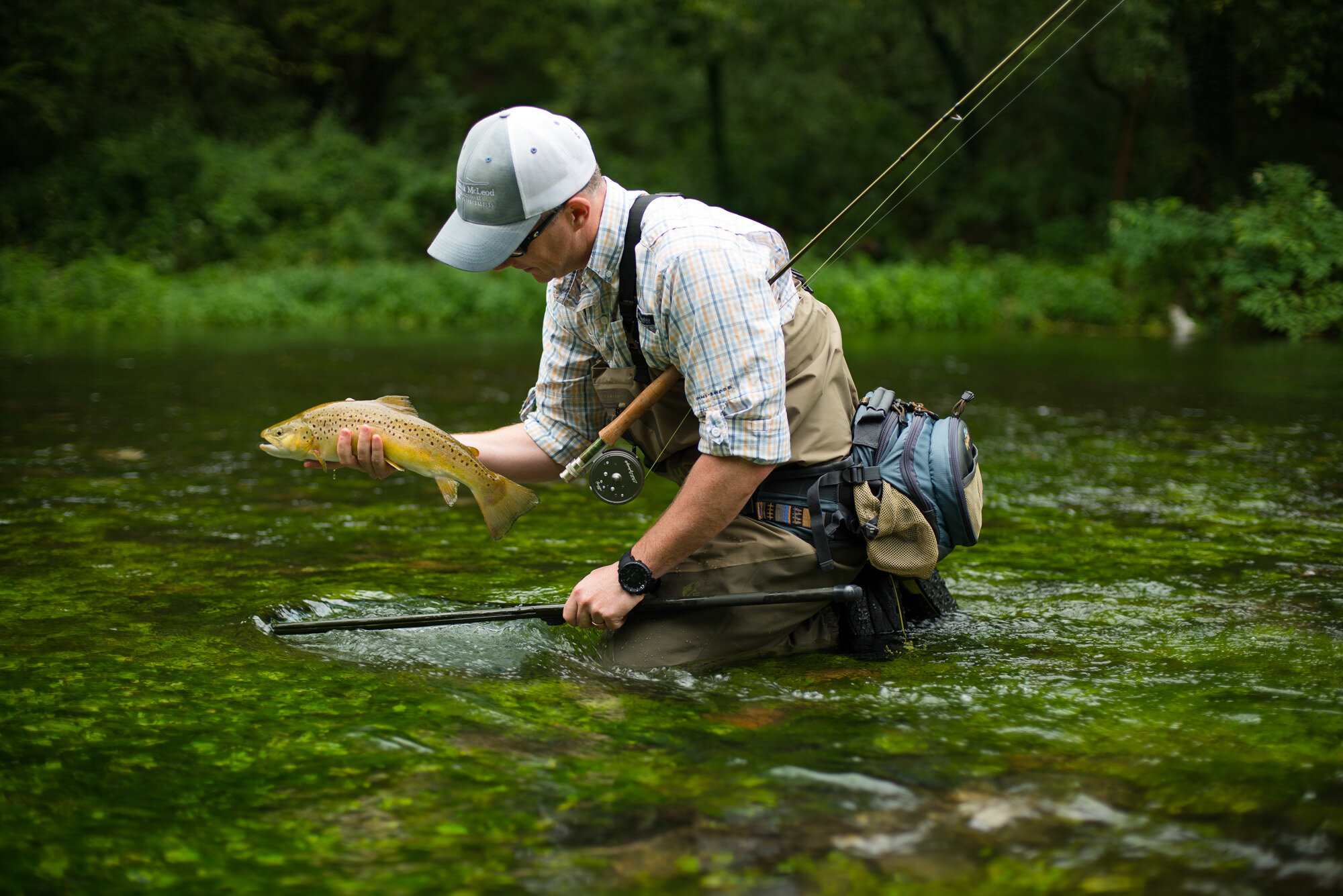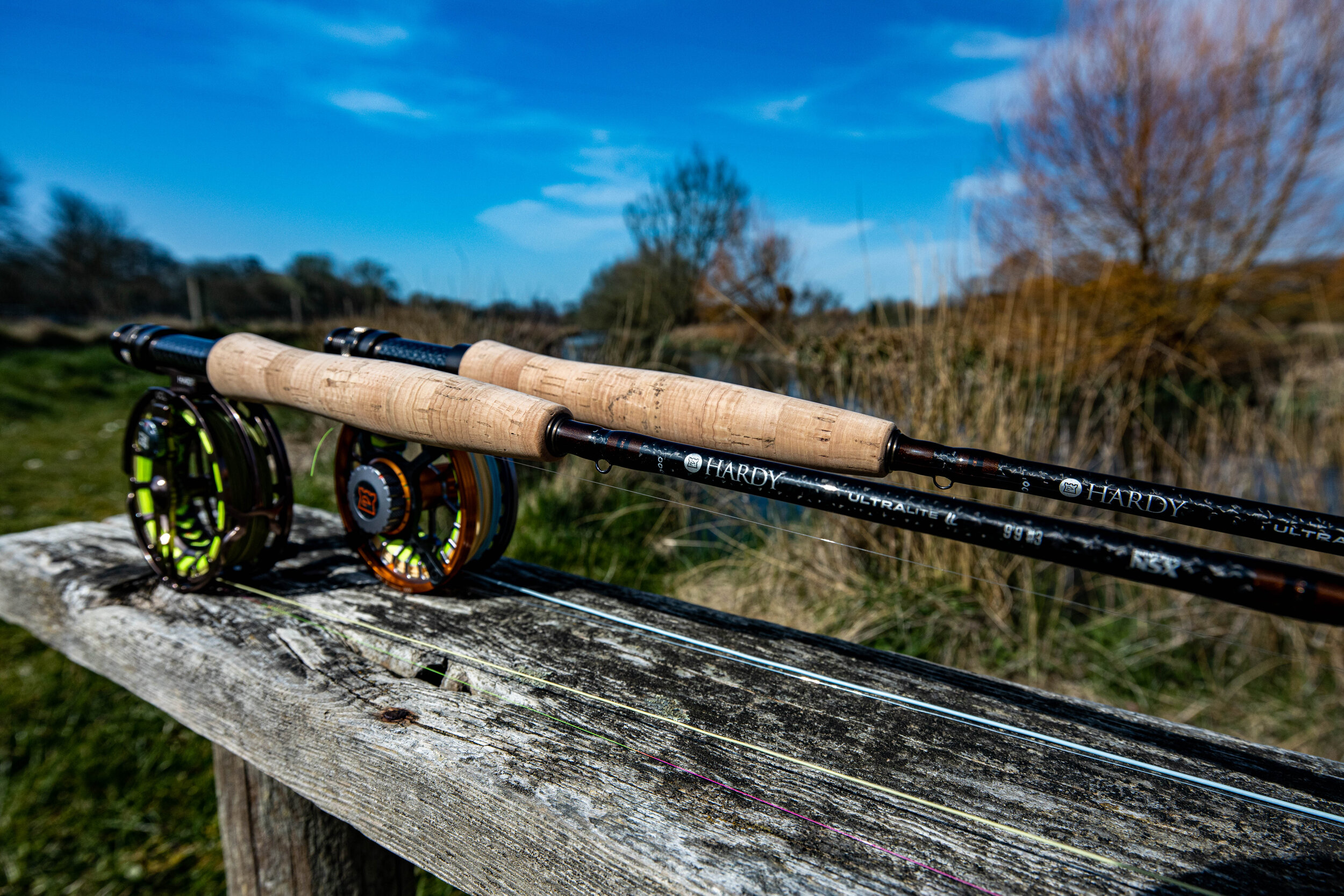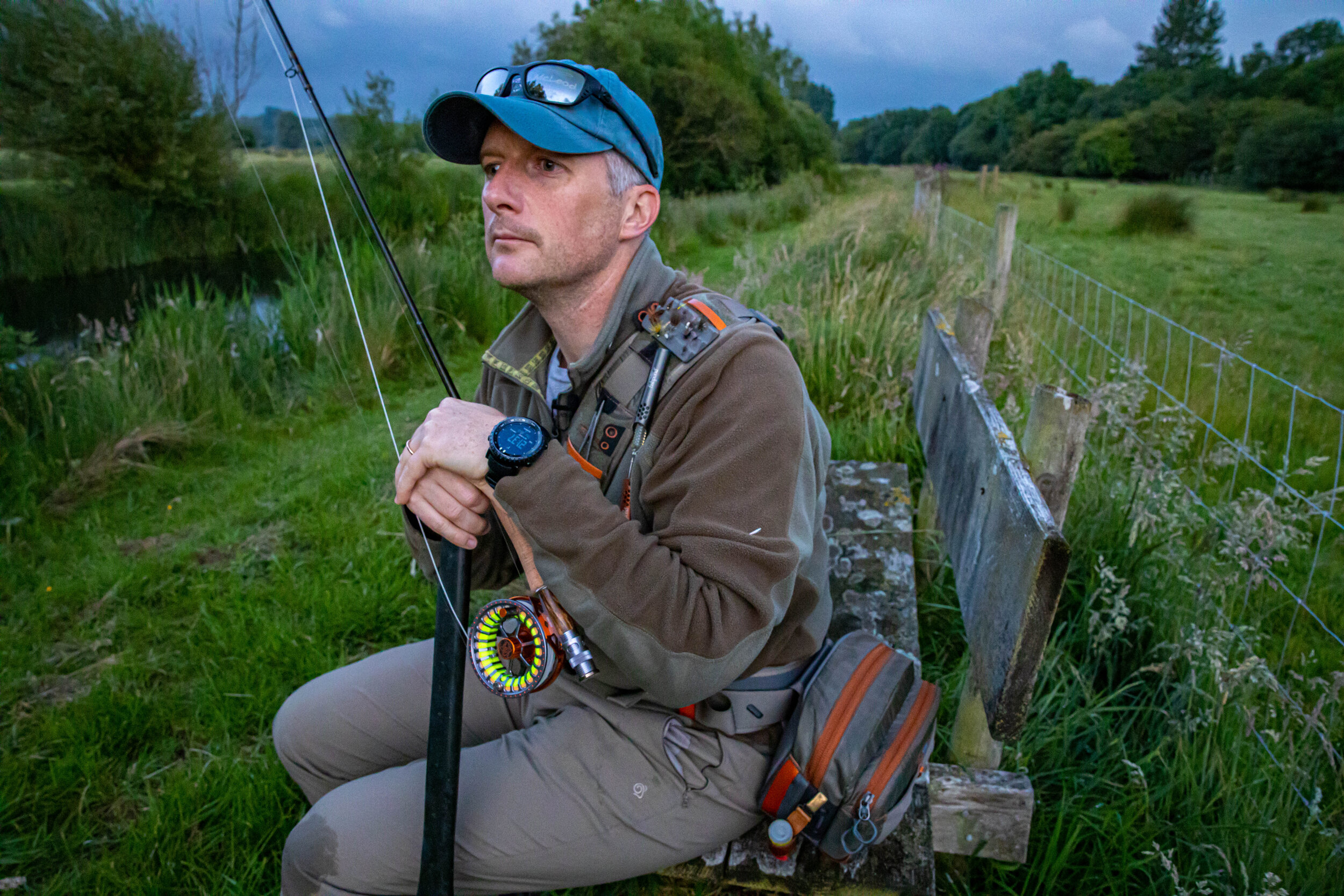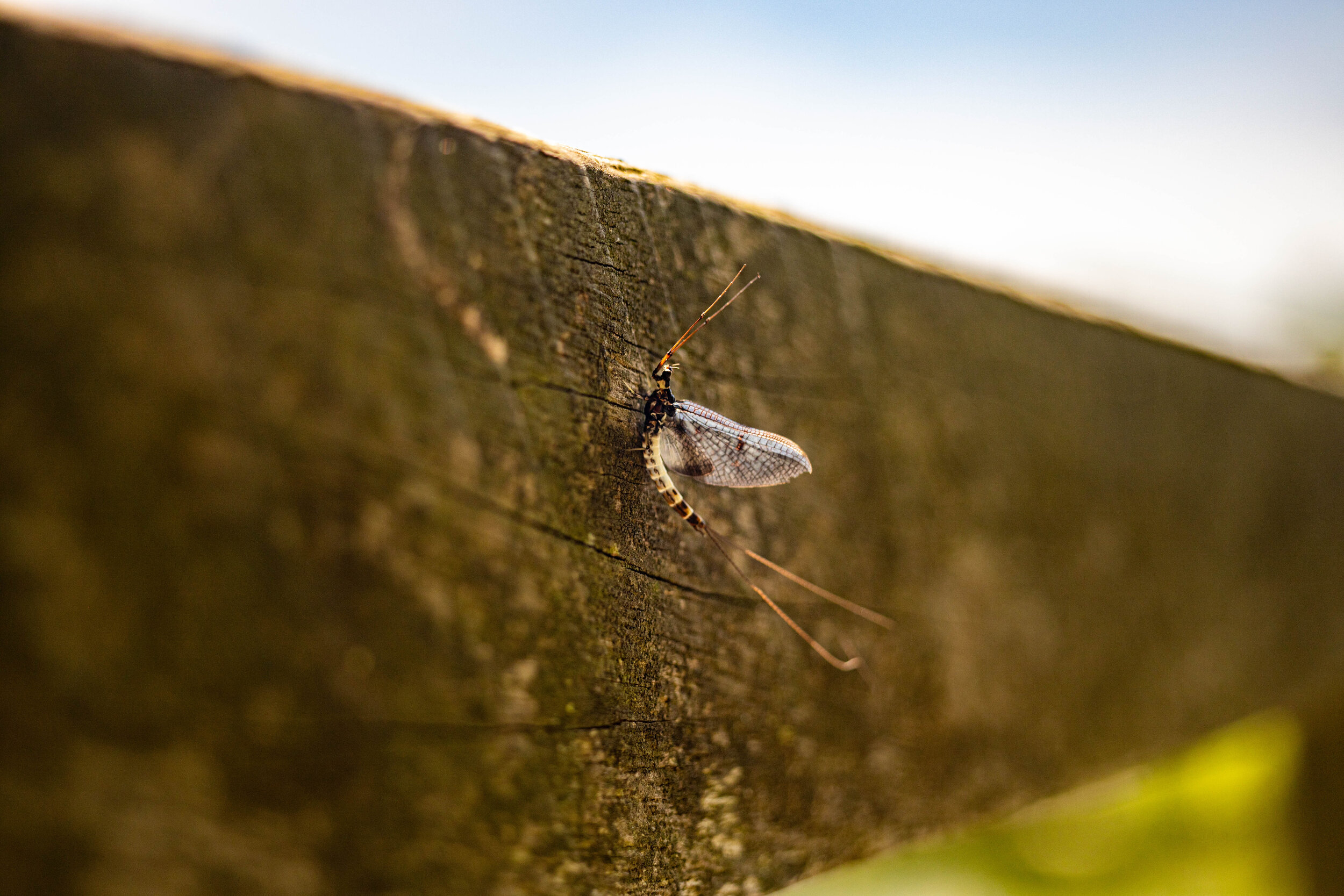
Peter McLeod
1. Choice of equipment rods, reels, fly lines, fly floatants, clothes, glasses and other useful items.
I freely admit, I am a tackle tart and I like to fish with nice toys. When it comes to rods I have to admit that I was slow to adopt the longer rods on rivers and for a long time I fished the more traditional 8’6” – 9’ 3# and 4#. As I also spend a lot of time in saltwater I have always preferred faster action rods to throw tight loops under overhanging branches.
However.. over the last three years I have moved, like so many, to the longer 9’9” – 10’ 3# and 4# rods. It has totally changed the way I approach and fish the Chalkstreams when I fish and when I guide. Instead of longer upstream casts, with the longer rod I can crawl up to the fish and get up close and personal. The length allows better line control and also getting over the longer fringe found on so many of our banks. My rods of choice are Hardys and currently I am using their 9’2” 4# Ultralite LL for bigger dry flies such as mayfly and sedge and the 9’9” 3# for smaller dry flies. These for me are the perfect blend of faster action but with softer tips for light tippet materials. For Iceland I used the Hardy Zephrus 9’6” 6# for extra punch with the weather and I find I can still get a 9’6” inside my bag for travelling.
When it comes to reels for trout fishing I like pretty ones. I admit it. Although not really necessary, I do prefer a disc drag reel to a click and pawl. I like the instant adjustability of a one turn drag where the drag goes from Zero to lock in one turn. A hangover from salt, I can’t stand not knowing exactly which drag mark represents which breaking strain or winding a drag three times to get appropriate tension. Currently I am using the Hardy MTX-S and Hardy UDLA reels currently.
For fly lines I am a big advocate for longer bellied fly lines on 4# and 5#. I like to be able aerilise the line to target, and if I miss, pick up straight away again without having to strip into a head and then cast. Quite often that can result in a missed opportunity. I am big fan of the RIO Technical Trout series as not only can it do this but also has a long front taper for a good presentation at range. For the 3# I use the RIO Perception. It is a little more compact in the head and loads up a 3# perfectly for short range with a beautiful light presentation.
Other essential pieces of kit I won’t go to the river without are Costa sunrise high viz glasses (an unfair advantage, the end..), Forceps, Amadou for drying sodden flies before treating, Fullers earth to degrease the leader (essential) Fishpond Nomad mid length net (best catch a release net I have ever had), compact down body warmer for when it gets cold, buff for sun and bug protection and knee pads. I bought these a while back after Paul Proctor recommended them and they saved my life.. and numerous sets of waders! For guiding it means I can crawl up to the fish and save my poor old knees! I wear a lumbar pack rather than a vest as I prefer the freedom of movement and am currently using the Fishpond Switchback which I love as its out the way when not in use.
2. Leader material, build up, length and knots.
I have to admit when it comes to leaders I live by KISS. Keep it simple stupid. I think the two key factors for me are length and diameter. Fish as long as you feel comfortable and as light as is feasible. For most of my fishing that is a 12 – 15’ leader going down to 4X during the mayfly to prevent spin and then to 6X for pretty much everything else. I will add 7X when fishing tiny dries and also nymphs for better penetration of the water column. Anything longer than that I have found becomes unmanageable on a Chalkstream and will undoubtedly result in being in the undergrowth. Casting on smaller streams such as the River Anton can be tight confines and there is no point in making it more complicated than it has to be. I freely admit I am too lazy to tie my own tapered leaders so I use shop bought tapered leaders in 9’ and 12’ such as Fullingmill Masterclass and then add tippet material as needed with a surgeons knot. These I always pull through warm hands to remove the coils before use. I use Copolymer tippet for dry flies and fluorocarbon for nymph fishing. I don’t like flourocarbon for dry fly fishing as although it sinks under the surface and vanishes I find it pulls the fly under every cast and quickly saturates it, especially tiny CDC flies.
3. Approach and stealth.
The approach and stealth are absolutely vital for the majority of fishing I do on the Chalkstreams. So many will blunder along the banks and then wonder why they don’t see any fish. Sight fishing, whether dry fly or nymph fishing is the name of the game. You can see them, but they can also see you. The first thing I do is take five and watch the river. You miss so much by cracking on straight away and its vital to just slow your pace down. They are wild creatures and can sense vibrations and noise, so move slowly. Keep low or your profile will appear in their cone of vision and spook the fish. This is often now where the kneepads and crawling come in. When scanning the river, don’t just scan from left to right, but pick an area and study it while looking for movement. Often you will catch a glimpse of a tail or a dart to the left or right as fish takes a nymph and betrays its position. Then move to the next area and so on. Drag is also key, if a fish sees drag it most often won’t take it (unless you are doing it on purpose to provoke a reaction) so you need learn methods to negate that. If dry fly fishing I always degrease my leader to prevent it flashing. Lastly, if you fluff the cast, let the fly drift well past the fish before picking it up and casting again.
4. Reading the water.
This is where fishing the Chalkstreams is slightly cheating. We have the luxury of being able to spot our quarry in the water to cast at and most of the time can watch its reaction to which fly pattern we have selected. As I mentioned before it’s possible to get very close quite often, hiding beneath the fringe. If you are stealthy you can change fly patterns a number of times without spoking the fish. When that is not possible the way I tend to explain this is energy conservation. Trout are not going to expend any more energy than absolutely necessary to lie or feed. When I look at a river and try and figure out where the fish would be I think of resting lies and feeding lies, mostly as I have watched individual fish move between these on water I fish regularly. Resting lies will be areas of cover, overhanging branches, weed beds, deeper pools undercut banks. Here they feel safe from predators. If there is no surface activity, these are the areas I will concentrate on.
If there is a hatch, be it olives during the day or perhaps a more consistent evening hatch, fish will come out onto their feeding lies. On Chalkstreams, this tends to be gravel patches or areas amongst the weed where the fish can lie under the main current, but maintain an easy vigil for drifting prey. Other riverbed topography such as tree roots, rocks and obstruction can also create these lies. These will often coincide with “feeding lines”, or areas where currents meet and food is pushed, like a food conveyor belt for the fish.
5. Casting ability which casts are essential.
The better you can cast, the more opportunities you are able to take advantage of. I think this is the case in which ever field of fly fishing you concentrate. When it comes to dry fly fishing the ability to cast a tight loop is very helpful for cutting into the wind and still presenting the fly gently or tucking a fly in under a bush or tree branch. Often on rivers we find ourselves surrounded by trees and undergrowth and the ability to know where your line is and what it is doing while you cast will prevent much frustration. I also firmly believe that being able to backhand cast is essential. To have the ability to switch and deliver an accurate cast backhand makes a huge difference to casting across the wind or in a tight spot.
Other casts I think help a lot are mid-air mends or reach casts. We all know that a drag free drift is essential for good fly presentation and is often the difference between success and failure. To accomplish this being able to mend the line to put slack in it is necessary. We don’t want to be mending that line on the water or you will spook the fish, so using an air mend or reach cast just allows you to do that before actually placing the fly.
6. Entomology, what should we know.
All trout fishermen should have a basic understanding of entomology to make the choice of what fly to use, even if it is the ability to tell the difference between a midge, olive, mayfly, sedge or terrestrial. How far you wish to take that is really up to you. The greater your understanding, the more accurate you can be. I certainly don’t think it is necessary to be able to identify a male from a female or remember all the Latin names, but the better you can identify the hatch, the more likely you are to be able to represent it and therefore be successful. (The Latin can help when talking to anglers in other countries as different areas have different local names for insects). Certainly fishing on these rivers it helps to be able to tell the difference between a Large Dark Olive, Blue Winged Olive, Pale Watery, Iron Blue Dun as fish will become totally clued in to one pattern. I also think that an idea of the “Yearly Fly Calendar” of what to expect when is helpful so you have the right flies in your box at the right times of year.
7. Rise forms Can they tell us something?
I am a huge advocate for studying the surface of the water, looking at, rather than into the water. Take your time, scan carefully under over hanging branches or vegetation. Often you might see a tiny a dimple, a subsurface bulge, the whole neb of a fish as it rolls or a “Free Willy” as a fish comes clean out of the water chasing an escaping insect. All of these will give away for those in know what they are feeding on and a pointer for which fly patterns to try. In sitting quietly and studying the river I have often been amazed how much is going on that normally many would miss as they march up the river.
8. Fly selection, size, shape, materials, which flies are essential, favourite fly.
As a general rule I start small and then go larger, unless it’s obviously mayfly, hawthorne or sedge the fish are taking. I am a huge fan of tiny CDC flies like so many. CDC Olives on size 18s, F-flies, Sherry spinners and the ubiquitous Griffiths Gnat in tiny sizes from 18 – 22 work well for me. I don’t tend to fish anything smaller than that as I can’t see it! I like foam in flies as well as they don’t sink.. Jardine’s emerger mayfly, foam back hawthorne and foam beetles for the alder beetles under tree branches have saved my neck more than once. For the mayfly I am a huge fan of the foam bodied Mohican Mayfly, and for the sedge the CDC High Ride Sedge are my go to patterns.
9. Presentation and drifts.
Presentation is vital and half the battle is the drift. Without the drift, you often won’t get the presentation. Half of this can be accomplished in the cast, the other half must be managed with line control. The presentation in the cast needs to be as gentle as possible. Cast above the water, not at the water. By casting above, the fly will have the chance to extend to the end of the cast and drop gently onto the surface. Most of the time you are aiming for a drag free drift to make the fly look as natural as possible. Currents can scupper this rapidly and even a cast with lots of slack can be affected by micro drag where the fish is. The closer your target is to the perpendicular of our bank, the faster drag will affect you. This can sometimes be negated by a longer cast at a more acute angle upstream to give you longer in the zone.
With the longer rods it is possible to fish another way as well. I have found I can almost Euro nymph with a dry fly. I am sure others have been doing this for ages, but for me it was a bit of a revelation. As most of our rivers here have a fringe and a bit of a drop to the water I can crawl up to where a fish is rising, peer through the fringe and present a dry on a dead drift leader with no fly line anywhere near it. This allows multiple casts over a rising fish, which if it is taking every fourth fly is useful. Its also extremely exciting is being right on top of the action you see every detail of the trout’s reaction to different patterns and the take.
10. Upstream or downstream?
Where I fish downstream fishing is not an option as it is against the rules on most Chalkstreams. However, on other streams where it is allowed, I think it can be highly effective as when done correctly can present a fly with no drag. It is harder than you think though and requires some practice to have enough slack or line feed to stop the fly waking on the surface. I think occasionally it is required if you need to reach fish in certain positions where it is not possible from downstream, such as in front of a bridge pillar, obstruction or tree.
11. Fighting fish.
I believe in fighting fish hard to return them strong. The fastest way to do this is to knock them off balance during the fight as it exhausts them faster. Taken directly from saltwater where fish can run hard and fast, I automatically drop the rod to one side in the opposite way to the direction the fish is running. This immediately creates side strain and will tire the fish much faster and shorten the battle. I also drop the rod lower as it then has to fight the whole power of the blank rather than just the tip. I will normally put a fish straight on the reel as then I know my pre-set drag will protect the tippet. If you become snagged during the battle then often slackening off entirely will relax the fish so it works itself out, but if it buries itself in weed then a steady firm pressure can often be the key to success as it works itself out. I just want to get that fish in the net fast so that it has the best chance of recovering and survival.













